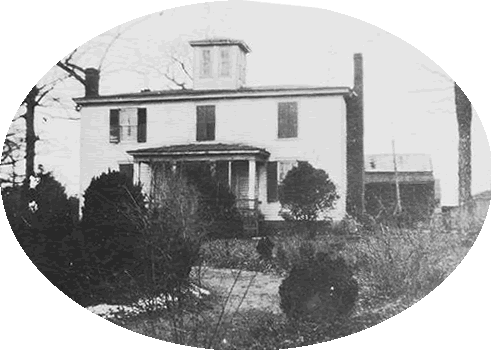- About Lunenberg
- African Americans
- Burials
- Census
- Churches
- Communities
- Miscellaneous
- Families
- History
- Houses & Landmarks
- Land
- Maps
- Marriages
- Resources
- Schools
- Taxes
- Wills
Oaksville<

Oaksville
Photo adapted by JoLee Spears from the digital WPA record at Library of Virginia
See "J. Hite" on Section
14 of 1864 Gilmer map of Lunenburg
Oaksville — Courtesy of June Banks Evans, September 30, 2001
It is believed that around 1845, shortly after buying the Blackwell land, James Land Hite began to enlarge and improve an existing home next to what is now Pine Lane, on the west side of the South Hill-to-Kenbridge road, #138. A photograph of Oaksville, taken for a WPA survey in 1937, shows a two-storey, unpainted, frame house with ten rooms, four fireplaces, an attached kitchen, and a small observatory on the third level. [LVA, VHIP/170005]
The house was comprised of two separate two-storey buildings connected by a one-storey, covered porch with columns at each end. Part of the rear building was of older, pegged construction over a rockwalled, whitewashed cellar with access steps from inside of the right rear room. Like many of the houses indigenous to the early colony, this building probably originated as a logged structure of two rooms, hall and parlor, with a dirt-floored cellar accessed through a trap door, a sleeping loft, and a rock chimney for heating and cooking.
Each of the corner posts would have been hewn out of a single tree trunk and the connectors would have been wooden pegs. Later, weatherboarding would have added, and as a protection against destructive fires, a kitchen building would have been constructed away from the main house, and the original dwelling would have been expanded to include a full second storey with enclosed stairs at a turned landing, and the third expansion would have been another room upstairs and another room downstairs, an open staircase, and an additional chimney.
At one of these stages, the building would have been raised several feet above ground with the sill beams supported on rows and/or piles of unmortared fieldstone. When the chimneys were heightened, this was usually done with local bricks. Around the Oaksville house was a large yard with English boxwood, a chinaberry tree, oak and hickory trees, with a circular drive at the front. The front door was double, with sidelights. The double door at the back of the house still had the original wooden security bar. The four mantels were high and carved of wood. Brass cornices were at the windows in the room at left front.
At one time a railing had surrounded the observatory, accessed by steps from one of the second level halls. In total, there were 23 windows in the house - ranging from 6 panes, 9 panes, 12 panes, to 18 panes. The wooden shingles of the roof had been replaced by rolled tin. The interior walls were plastered; the pine doors had four and five panels. The two sets of interior stairs featured circular railings with square newel posts and balusters. Except for doors to the side porch, the only connection between the front building and the rear building was through the open-air, one-storey colonnade.
In addition to a wide hall on each floor, the front building had a parlor and bedroom downstairs, with two bedrooms upstairs; the rear building had a bedroom and dining room downstairs, with two bedrooms upstairs. There was a door from the right front downstairs bedroom opening onto the side porch connecting to the porch of the kitchen building attached at the northwest corner of the main house.
Another [undated] photograph shows there was an iron fence at the front of the house, and some of the windows had shutters. [Conversations: Audrey and Eugene Smith, July 2001; WPA report of Mary N. Boykin, 1937]
Set off to one side of the Hite house was another older structure referred to as the red house, which is said to have been moved from another site on the property and was where James and his family lived while the renovation was going on. Referring to the earlier history of these parcels purchased by James L. Hite, the assumption is that the red house could have been the former dwelling of Samuel Ussery or of Henry Freeman, and the pegged part of the renovated house was probably the former dwelling of John Ussery, Jr., that had been used between 1810 and 1823 by the family of Robert and Jane [Jones] Blackwell.
This land and its stately home remained in the control of the Hite family until the middle of the twentieth century, but after the death of James's youngest son, Robert Land Hite in 1946, the land was divided, the furnishings of the house were sold, the building components were dismantled, and the remaining structure was burned. Nothing remains as evidence of the families that lived there over so many years.
(By permission of June Banks Evans from Kettlestick, Flat Rock, Tar Kiln, Crooked Run: Using Virginia Land Records in Family History -- with Blackwell, Hite, Ussery, Pettway, Bryn Ffyliaid Publications, 2001)

